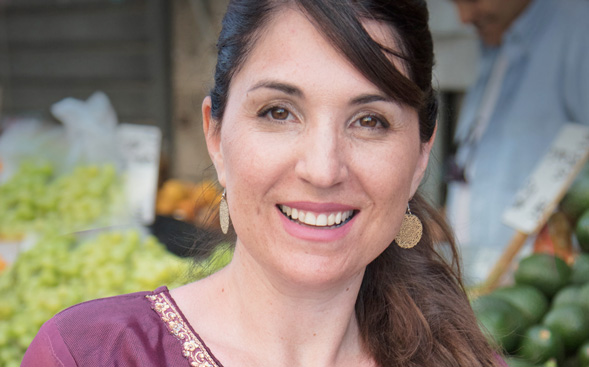
FROM SARAH, OUR SABRA
ON THE GROUND IN ISRAEL

Dear Friend,
Greetings from the Holy Land. I remember as a child watching the movie The Late Great Planet Earth, based on a book by Hal Lindsey, which details the events of the End Times. I was probably too young to understand the movie, and I certainly had not read the Books of Daniel and Revelation. Thus, what I saw in the movie, coupled with an early exposure to the Holocaust (which is normal for a Jewish child growing up in Israel), created a strange mix inside my brain.
These two influences resulted in a series of recurring dreams about the persecution of Believers in Yeshua/Jesus as Messiah during the End Times, which I remember vividly to this day. I dreamt about people living and hiding in and under a clump of massive trees in a vast field. In another dream, I recall seeing families “running for the hills” eastward in the desert. And in yet a third dream, threatening men in uniforms ferreted out people from hideouts behind false white plaster walls in homes. I dreamt of Believers being caught and taken to prison, where I knew that they would face interrogation and execution.
Persecuted Believers
Growing up in Israel, with its guarantee of religious freedom for all faiths, I did not experience the difficulties that Believers face today in many parts of the world. However, during my work on a recent music project in Arabic and Farsi, I talked with Believers from the Middle East who experienced severe persecution.
Their courage and joy amazed me as they disclosed harrowing details of government crackdowns — horrible abuse and violence, imprisonment, torture, genuine fear of death, and much more. I wondered how they maintained their faith and community life in such hostile environments.
One of these oppressive areas is the Islamic Republic of Iran. There are very few state-recognized churches in the capital Tehran. In addition, the government constantly watches the people in those churches, limits attendance (only a fourth of the congregation could meet at once), and controls what is preached. Iranian Believers are also subject to periodic arrests and constant questioning.
As such, large numbers of Believers in Iran meet in homes. Sometimes they cannot openly communicate about the church’s meeting times. I heard of some who rely on the Holy Spirit to tell attendees when they would come together. During their gatherings, the Believers close all the shutters and windows and they “sing” their worship in whispers so that no one outside hears what is happening inside the house.
Persecution typically means that traditional church buildings and large gatherings can become dangerous, attracting unwanted attention. “House churches” (similar to those in Iran) are a viable — and Biblical — solution because they allow Believers to continue worshiping, growing in faith, and spreading the Gospel despite opposition. I believe that the house-church model can greatly strengthen a person’s faith and encourage longevity in the faith community. This model also offers unexpected advantages for nurturing children and the next generation of Believers.
Early House Churches
The early Believers initially met in the Temple and in various houses. As the Book of Acts notes: “Every day they continued to meet together in the temple courts. They broke bread in their homes and ate together with glad and sincere hearts” (Acts 2:46).
As the first century progressed, however, the Jewish leaders persecuted Believers, who soon stopped meeting in the Temple. As the Gospel spread beyond Judea and the Middle East, many early Believers apparently met in houses. Paul wrote to the church that met in Priscilla and Aquila’s home (Rom. 16:5), and later to the church that met in Philemon’s home (Philem. 1:2).
During the second and third centuries, Believers faced increasing persecution and continued gathering in homes for worship and discipleship. Even in this setting, the Christian faith continued to grow. And what was beneficial for Believers in the first few centuries is fast becoming valuable for Believers in the 21st century.
Helpful Model For Today
As we move into more uncertainty — especially politically and religiously — in many places around the world, the house-church model offers many advantages. Without fixed locations, these churches are harder than traditional churches for authorities or extremist groups to locate. Thus, Believers can worship discreetly, in relative safety. Smaller group sizes also mean that fewer people are involved, which decreases the chances of subversive individuals infiltrating the fellowship.
House churches foster a stronger sense of community because no one can enter or leave a worship gathering without speaking to others. There simply isn’t a crowd for people to “get lost in,” as is typical in many large churches (especially in the U.S.). In a house setting, Believers typically share meals, pray together, engage in meaningful discussions, ask questions, and receive personalized guidance in their faith journey. All these interactions increase the love between community members and facilitate effective discipleship for newer Believers.
Growth in the traditional church model requires buildings, land, and money. Likewise, many human resources are needed to organize and maintain those assets. On the contrary, a house-church model primarily requires a group of willing Believers with capable leadership and sound teaching. And, as the Gospel expands, this model responds quickly and organically to growth, as we have seen in restrictive countries like Iran and China.
Challenges and Benefits
While the house-church model has many benefits, it also presents challenges that must be addressed. The perceived lack of structure could allow for rude and disorderly behavior. Plus, leaders of house churches should be mature Believers who ensure that sound doctrine is being taught and who protect against doctrinal drifts.
New Believers who come to faith also need to be exposed to the larger body of Messiah. Thus, home fellowships will ideally engage with other Believers in a specific region and nation through ministry work and periodic larger gatherings, such as conferences.
In our community here in Israel, I have discovered two significant benefits of the small group setting that prioritizes active participation over spectatorship: 1) It’s a natural place to mentor new Believers more effectively, and 2) It is an excellent place to disciple children. When you keep the younger generation in “the main meeting,” you invest in their ability to communicate effectively about their faith. Thus, you inoculate them against the false doctrine and lies that our enemy uses to lure Believers away from truth and faith. Additionally, as children watch their parents discuss faith issues and their own experiences, it becomes much more natural for the kids to do the same. Finally, children in this multi-generational environment are enriched by a variety of spiritual understandings and maturity as they worship, study Scripture, discuss, and pray together. This is a vast departure from programs that separate children from their parents during services and/or where one individual delivers a weekly message.
The Megachurch
My first visit to an American megachurch was an almost unbelievable experience. The sheer size of the worship center amazed me. Its massive stage, professional lighting, swirling images on the screen during worship, impressive sound systems, professional musicians, talented singers, and charismatic preaching were enticing.
Later, as I walked around through other buildings on the megachurch’s campus, I found exceptionally well-equipped children’s program rooms, a beautiful bookstore flowing with resources, and a coffee shop with mouthwatering treats. I can understand why many people like this — they want to take part in a venture that is larger than life and experience the external impact that these organizations can have because of their massive financial resources.
Still, I believe that the megachurch model can cultivate a lack of commitment and connection, which can lead to a lack of personal maturity and accountability. In addition, the megachurch often fosters an unhealthy idolization of its leaders.
A Church for the End Times
The year 2020 shifted perspectives for many people. The government quickly enforced restrictions on large gatherings. Israeli airports closed within days of the coronavirus arriving here; we couldn’t fly out of the country for over 18 months. We in Israel had to have our temperature checked just to shop for essentials like food and medications! Almost overnight, many of life’s necessities were difficult to get.
The events of the pandemic, along with Hamas’s atrocities against Israel on October 7, 2023, taught me that life as we know it can change drastically in a moment. For many people, especially us Jews in Israel, these events are important reminders that we can’t take for granted our current sense of peace, security, and freedom.
While you and I don’t know what the future will bring, the outlook is becoming clear: More End Times birth pangs will bring increasing danger for and persecution of individuals who follow the God of Israel. Thus, we must prioritize “future-proofing” our personal church options. Just as those who live in disaster- prone areas prepare ahead of time by storing supplies and securing shelter, so we Believers need to prepare for times of difficulty and persecution.
If you are not part of a small, local, supportive community, please consider making the necessary investments of time and energy now for when the need arises. Who can you rely on in your immediate area? How close is your faith community if you were to have to gather with them by walking or biking? Do you have a group that regularly prays together, encourages one another, and can facilitate growth for new Believers through sound teaching and discipleship? What relationships do you have in place in which you support others and receive support? How can you communicate with those people if there is no electricity?
I urge you to ask the Lord to reveal the people around you, especially Believers, whom He would have you meet with and invest in now as you prepare for the future.

Im tirdefu lada-at oto —“Press on to know HIM!” (Hosea 6:3 NLT)
Many blessings from Israel,

Sarah Liberman
P.S. What benefits have you experienced from being part of a house church or small community group with other Believers? Please email me at staff@levitt.com or write to our P.O. Box and share your story. I would love to hear it!
 Where the Church Began
Where the Church Began
Pilgrimages to the Holy Land can reveal what life was like in Biblical times. On our Bible study tour, you will see what Israel was like in ancient times but also experience the vibrant, modern-day Israel — how dry bones (Eze. 37:1–14) have come to life!
Join us on a Zola Tour to learn about Israel’s past, present, and future. Contact Sandra, our tour manager at 214-696-9760, travel@levitt.com, or levitt.com/tours for more information or to reserve your spot on our upcoming Fall 2025 tour.
Fall Tour 2025 options
| Deluxe — Israel | Oct. 20–Oct. 30 | $5,288 |
| Grand Petra — Israel & Petra | Oct. 20–Nov. 2 | $6,888 |

A Note from Joshua and Caleb Colson
As the Bearded Bible Brothers®, we’ve often taught during the last six years under the title of “God’s Mobile Church.” Many of our teachings could be considered “sermons your pastor doesn’t want you to hear!” Below might be another message that he wouldn’t tell you.
In her letter, Sarah noted some problems that are inherent in megachurches. Unfortunately, many megachurches struggle with the debt and upkeep of their multimillion-dollar facilities. Therefore, they sometimes declare a false interpretation of tithes. In addition, their teaching is often designed to instill loyalty to their congregation alone — only that particular church is “The Church” described in the Bible, while all others are false!
Many Christians who mention “the Church” are really referring to a building. But the Church is not a structure — it’s all the people who are “in Christ” (Rom. 12:5; Gal.3:28). The born-again individuals inside the edifice are Yeshua’s hands and feet; they don’t require a building to function.
It’s difficult these days to “lead a sinner to Jesus” in a holy box — a church building. How many lost souls do you know who would care to visit a megachurch after the many recent reports about pastors caught in scandals? What we call the “Last Days Apostate Church” has become just that — a den of compromise that doesn’t offer the same level of enticement that the secular world delivers related to entertainment and self-indulgence. Why would the world want a watered-down version of itself?
Thankfully, when Yeshua declared, “It is finished” (John 19:30), He meant just that! The veil separating the Holy of Holies was actually torn in two. God was no longer confined to a box; people no longer needed a mediator like the high priest to connect them with God. Since then, humans have had direct access to God. No matter how stained and sinful they are, the unsaved can receive redemption through faith because of the atonement that came through Yeshua’s blood. And after Yeshua’s resurrection, the Holy Spirit made His home in human hearts. Thus, the Church became mobile!
“Do you not know that your bodies are temples of the Holy Spirit, who is in you, whom you have received from God? You are not your own…” (1 Cor. 6:19)
As Sarah noted, the first Christians met in homes, marketplaces, and open squares. (To see Zola’s 10-program TV series The First Christians, visit levitt.tv/media/series/VFC.) We don’t believe it’s an accident that God is returning Believers — those who worship Him in spirit and in truth — to the same format today. All modern orthodoxies, denominations, and church systems were instituted and promoted by men. Incorrectly, they often proclaim the pastor — rather than Messiah — as the head of the Church. That is why we’re excited to see God hit the “reset button.”
Humans will never be satisfied with a frail imitation of God’s glory. Because time is cyclical, we’re seeing Believers return to the Book of Acts construct as originally designed by the Holy Spirit. And predictably soon, we’ll see the outpouring of the Holy Spirit with greater power, as Joel chapter 2 suggests.
Sha’alu shalom Yerushalayim! — “Pray for the peace of Jerusalem!” (Psalm 122:6),

Joshua and Caleb
P.S. Time is drawing to a close. There’s no more time to “play Church” — we must now be the Church.

Our Jewish Roots TV programs in April
David and Kirsten Hart
We are grateful for the beautiful month of April. Chag Pesach Sameach (Happy Passover)! Passover and Holy Week are significant times for Believers. As you experience these Holy Days, we pray that you will draw closer to the Lord, and in turn, He will draw closer to you (James 4:8).
This month, Our Jewish Roots features the final three programs in Rebuilding the Ruined Cities, which you can view free online at levitt.tv/ media/series/DRRC. These 12 powerful programs remind Believers that God keeps His promises to His people and His land! We would love to hear how this series has impacted you. Please write to our P.O. Box or email us at staff@levitt.com to share what you have gained from the programs.
At the end of April, we will begin re-airing the series, Roadmap to Armageddon, which you are invited to watch for free at levitt.tv/media/series/DRTA. Buckle up and join Joshua and Caleb as they journey in a Jeep through the Holy Land!

Rebuilding the Ruined Cities
The Re-Birth — On the streets of Tel Aviv, the Bearded Bible Brothers reveal how God kept His promise to bring the Jewish people home. Out of the horrors of the Holocaust, prophecy was fulfilled and Israel was reborn. Joshua and Caleb recall the early Jewish settlers who experienced the desert blooming like a rose!
The Nations Rage — Who are the “Palestinians”? Do they have an ancient claim to the Promised Land? Joshua and Caleb address the truth behind the current conflicts when they journey to Tel Ashkelon, the former stronghold of the Philistines, Israel’s ancient enemy. The brothers also explain modern Israel’s past wars — which began just after the nation’s rebirth in 1948 — and foreshadowed the present-day aggression.
The Future — Israel’s Independence Day has finally arrived. The Bearded Bible Brothers visit a beach in Tel Aviv to explain the future prophetic events that will lead to Israel’s redemption. Although there are many Biblical conflicts to come — from Psalm 83 to Armageddon — God will uphold His Word and Covenant to complete Israel’s restoration.
Roadmap to Armageddon
The Psalm 83 War — Why does Satan continuously rally the nations in animosity against Israel? Joshua and Caleb, the Bearded Bible Brothers, travel to Israel’s northern border with Lebanon to discuss the age-old hatred against the Jewish people. Has the Psalm 83 War already been fulfilled, or could it occur during our lifetime? Join us as we begin our journey on the Roadmap to Armageddon.

 Zola Levitt Ministries is ECFA approved and has Charity Navigator’s top rating of 4 stars, plus Ministry Watch’s Give With Confidence Score of 100.
Zola Levitt Ministries is ECFA approved and has Charity Navigator’s top rating of 4 stars, plus Ministry Watch’s Give With Confidence Score of 100.




